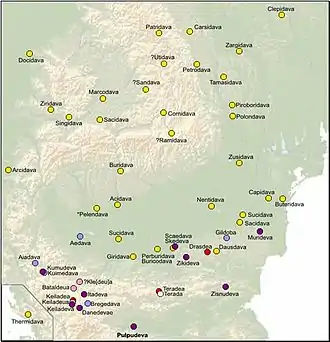Tinosu (archaeological site)
Tinosu or Pisculeşti was the location of a Dacian fortified town, occupied sometime between the 2nd century BCE to 1st century CE.[1]
 Shown within Romania | |
| Alternative name | Pisculești |
|---|---|
| Location | Pisculeşti, Romania |
| Coordinates | 44.8252°N 26.0122°E |
| History | |
| Abandoned | 1st century CE |
| Site notes | |
| Archaeologists | Cezar Bolliac |
| Condition | Ruined |
Located on the eastern bank of the Prahova River, the town was fortified with a fosse and wall topped with a palisade.[1] The site was excavated by Cezar Bolliac in the 1860s.[2] Discoveries of Getic and Roman coins from the reign of Claudius have allowed archaeologists to date its occupation.[1]
References
- Sencovici, Mihaela (2004–2005). "Types of Geto-Dacian settlements and dwellings in Ialomiţa basin" (PDF). Annals of Valahia University of Târgovişte, Geographical Series. 4–5: 290–293.
- Enea, S.-С. (2012). "Romanian prehistoric archaeology, between tradition and innovation". Археологія і давня історія України. 36: 93–102. ISSN 2227-4952 – via Наукова електронна бібліотека періодичних видань НАН України.
This article is issued from Wikipedia. The text is licensed under Creative Commons - Attribution - Sharealike. Additional terms may apply for the media files.
